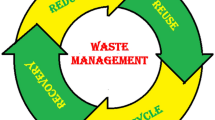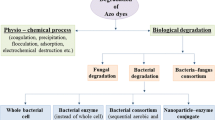Abstract
The largest and fastest growing industry in the world is electronic industries and the generation of waste are emerging problem. Electronic wastes are the source of precious metals that contributes 40 to 50 times more than the ore extracted from mines. The recycling of the waste is very important as it can protect the earth’s natural resources. There are various methods for recycling e-waste such as chemical, fire, physical, and mechanical method. Currently, chemical treatment is in practice for recycling but, due to the usage of inorganic chemicals, it gives more environmental issues. Therefore, this paper used the biological method to prepare the nanoparticle from e-waste as it is an eco-friendly method. The copper and ferrous nanoparticle was extracted from the e-waste and biologically reduced using lichen-associated bacterial such as Parmotrema tintorum and P. recticulatum. The characteristics of these nanoparticles such as size, shape, and functional group were analyzed using UV, PSA, SEM, and FTIR respectively. The size of the synthesized particle was in the range of 10–100 nm using PSA. At the 2.5% concentration, the synthesis of ferrous nanoparticles was confirmed by the peak value obtained at 430 nm and 540 nm for copper nanoparticles. The antifouling properties of synthesized nanoparticles were analyzed by colliding them with the paint and applying to the iron surface. In recent research, the nanomaterials were able to use to reduce the fouling activity, also prevent harmful effects to the other marine species and the resistance of some microorganisms to antifoulants. This study helps to prevent environmental contaminants by using the copper and ferrous nanoparticle substances synthesized from the e-waste materials with the help of bacterial reduction.









Similar content being viewed by others
Data Availability
The raw reads generated in this study were discussed in the “Result and discussion” sections. Lichen-associated bacteria were deposited into the NCBI Sequence database, Maryland, USA, with accession number (MG101839, MG087839, MG063273, MG190340, MG189586, MG190323).
Abbreviations
- FeNps :
-
Ferrous nanoparticles
- CuNps :
-
Copper nanoparticles
- FTIR :
-
Fourier Transform Infrared Spectroscopy
- nm :
-
Nanometer
- SEM :
-
Scanning electron microscopy
- UV-Vis :
-
Ultraviolet-visible spectroscopy
- cm −1 :
-
Centimeter
References
Islam, A., Swaraz, A. M., Teo, S. H., Taufiq-Yap, Y. H., Vo, D. V. N., Ibrahim, M. L., Alsultan, G. A., Rasdhid, U., & Awual, M. R. (2021). Advances in physiochemical and biotechnological approaches for sustainable metal recovery from e-waste: A critical review. Journal of Cleaner Production, 323, 129015. https://doi.org/10.1016/j.jclepro.2021.129015
Mathew, A.A., Parthasarathy, P., Vivekanandan, S. (2021). Development of copper nanoparticles from E-waste for biomedical applications. In: Komanapalli, V.L.N., Sivakumaran, N., Hampannavar, S. (eds) Advances in automation, signal processing, instrumentation, and control. i-CASIC 2020. Lecture Notes in Electrical Engineering, vol 700. Springer, Singapore. https://doi.org/10.1007/978-981-15-8221-9_64.
Işıldar, A., Rene, E. R., van Hullebusch, E. D., & Lens, P. N. L. (2018). Electronic waste as a secondary source of critical metals: Management and recovery technologies. Resources, Conservation and Recycling, 135(December 2016), 296–312.
Gokul, V., & Rajasekaran, T. (2019). Electronic waste management by biological leaching. Bulletin of Scientific Research, 1, 54–61. https://doi.org/10.34256/bsr1918
Thouvenin, M., Langlois, V., Briandet, R., et al. (2003). Study of erodable paint properties involved in antifouling activity. Biofouling, 19, 177–186. https://doi.org/10.1080/08927014.2003.10382980
Olivera, S., Hu, C., Nagananda, G. S., et al. (2018). The adsorptive removal of Cr (VI) ions and antibacterial activity studies on hydrothermally synthesized iron oxide and zinc oxide nanocomposite. Journal of the Taiwan Institute of Chemical Engineers, 93, 342–349. https://doi.org/10.1016/J.JTICE.2018.07.042
Qiu, H., Feng, K., Gapeeva, A., et al. (2022). Functional polymer materials for modern marine biofouling control. Progress in Polymer Science, 127, 101516. https://doi.org/10.1016/J.PROGPOLYMSCI.2022.101516
Noel, A., Garnier, A., Clement, M., et al. (2021). Lichen-associated bacteria transform antibacterial usnic acid to products of lower antibiotic activity. Phytochemistry, 181, 112535. https://doi.org/10.1016/J.PHYTOCHEM.2020.112535
Ibrahim, G. P. S., Isloor, A. M., Inamuddin., et al. (2020). Tuning the surface properties of Fe3O4 by zwitterionic sulfobetaine: Application to antifouling and dye removal membrane. International Journal of Environmental Science and Technology, 17(9), 4047–4060. https://doi.org/10.1007/S13762-020-02730-Z.
Khatami, M., Ebrahimi, K., Galehdar, N., Moradi, M. N., & Moayyedkazemi, A. (2020). Green synthesis and characterization of copper nanoparticles and their effects on liver function and hematological parameters in mice. Turkish Journal of Pharmaceutical Sciences, 17(4), 412–416. https://doi.org/10.4274/tjps.galenos.2019.28000
Loredo-Becerra, G. M., Duran-Almendarez, A., Calvillo-Anguiano, A. K., DeAlba-Montero, I., Hernndaez-Arteaga, L. O., Ruiz, F. (2022). Waterborne antifouling paints containing nanometric copper and silver against marine Bacillus species. Bioinorganic Chemistry and Applications. 2435756. Published Feb 15. 14 pages. https://doi.org/10.1155/2022/2435756.
Shi, W. Z., Liang, Y. S., Lu, B., Chen, M., Li, Y., Yang, Z. (2019). Cuprous oxide nanoparticles: preparation and evaluation of antifouling activity. Química Nova, 42(6), 638–641. https://doi.org/10.21577/0100-4042.20170374
Al-Rawi, M., Al-Mudallal, N., Taha, A. A. (2021). Determination of ferrous oxide nanoparticles minimum inhibitory concentration against local virulent bacterial isolates. Archives of Razi Institute, 76(4), 795–808. https://doi.org/10.22092/ari.2021.355997.1758.
Win, T. T., Khan, S., Bo, B., et al. (2021). Green synthesis and characterization of Fe3O4 nanoparticles using Chlorella-K01 extract for potential enhancement of plant growth stimulating and antifungal activity. Science and Reports, 11, 21996. https://doi.org/10.1038/s41598-021-01538-2
Khaliq, A., Rhamdhani, A. M., Brooks, G., & Masood, S. (2014). Metal extraction processes for electronic waste and existing industrial routes: A review and australian perspective. Resources, 3, 152–179. https://doi.org/10.3390/resources3010152
EL Bar, D., Barket, D. (2018). Chemical industry department; laboratory of chemical molecular, leaching of metals from hydrometallurgical residue by sulfuric acid. Aspects in Mining and Mineral Science, 1(4), 108–113. https://doi.org/10.31031/AMMS.2018.01.000518.
Biosca, E. G., Flores, R., Santander, R. D., Gil, J. L. D., Barreno, E. (2016). Innovative approaches using lichen enriched media to improve isolation and culturability of lichen associated bacteria. Plos one, 11(8), 1–22. https://doi.org/10.1371/journal.pone.0160328.
Rubavathi, S., Ayyappadasan, G., & Brindha, R. (2022a). Self-potent antimicrobial and antifouling action of silver nanoparticles derived from lichen associated bacteria. Applied Nanoscience, 12(6), 2397–2408. https://doi.org/10.1007/s13204-022-02501-x
Shantkriti, S., & Rani, P. (2014). Biological synthesis of copper nanoparticles using Pseudomonas fluorescence. International Journal of Current Microbiology and Applied Science, 3(5), 374–383.
Subba, R. T., Murthy, P. S., Veeramani, P., Narayanan, D. S., Ramesh, R., Jyothi, B. N., Muthukumaran, D., Murugesan, M., Vadivelan, A., Dharani, G., Santhanakumar, J., & Ramadass, G. A. (2021). Assessment of biogrowth assemblages with depth in a seawater intake system of a coastal power station, 37(5), 506–520. https://doi.org/10.1080/08927014.2021.1933457
Rezakazemi, M., Dashti, A., RiasatHarami, H., et al. (2018). Fouling-resistant membranes for water reuse. Environmental Chemistry Letters, 16(3), 715–763. https://doi.org/10.1007/S10311-018-0717-8
Rubavathi S., Ayyappadasan G., Saranya, D. (2022b). In Vitro enzymatic screening and assessment of the Lichen-associated Bacteria and its evaluation of antifouling studies. Periodico di Mineralogia, 91(3), 188–200. https://doi.org/10.37896/pd91.3/91315
Krishnand, S. I., Tariq, A. S., Nazir, A. B., Faroog, A. A., Jagan, C. S., Faheemn, C. S., Ahmed, Z. E., Asma, A. A. H., & Faheema, K. (2021). Copper nanoparticles: Green synthesis and managing fruit rot disease of chilli caused by Colletotrichum capsica. Saudi Journal of Biological Sciences, 28(2), 1477–1486. https://doi.org/10.1016/j.sjbs.2020.12.003
Dawoud, T., Alharbi, N. S., Theruvinthalakal, A. M., Thekkangil, A., Kadaikunnan, S., Khaled, J. M., Almanaa, T., Sankar, K., Innasimuthu, G. M., Alanzi, K. F., Rajaram, S. K. (2019). Characterization and antifungal activity of the yellow pigment produced by a Bacillus sp. DBS4 isolated from the lichen Dirinaria agility. Saudi Journal of Biological Sciences, 27(5), 1403–1411. https://doi.org/10.1016/j.sjbs.2019.11.031
Inamuddin, & Kanchi, S. (2020). One-pot biosynthesis of silver nanoparticle using Colocasia esculenta extract: Colorimetric detection of melamine in biological samples. Journal of Photochemistry and Photobiology A: Chemistry, 391, 112310. https://doi.org/10.1016/J.JPHOTOCHEM.2019.112310.
Sharma, P., Goyal, D., & Chudasama, B. (2022). Antibacterial activity of colloidal copper nanoparticles against Gram-negative (Escherichia coli and Proteus vulgaris) bacteria. Letters in Applied Microbiology, 74(5), 695–706.
Loredo, B., Almendaarez, A. D., Calvillo-Anguiano, A. K., Montero, I. D. , Herna´ndez-Arteaga, L. O., & Ruiz, F. (2022). Waterborne antifouling paints containing nanometric copper and silver against marine Bacillus species. Hindawi Bioinorganic Chemistry and Applications, Article ID 2435756, 14 pages. https://doi.org/10.1155/2022/2435756.
El-Nasr, R., Abdelbasir, S., Kamel, A., & Hassan, S. (2020). Environmentally friendly synthesis of copper nanoparticles from waste printed circuit boards. Separation and Purification Technology, 230. https://doi.org/10.1016/j.seppur.2019.115860.
El-saied, H. A. A., Ibrahim, A. M. (2020). Effective Fabrication and characterization of eco-friendly nano chitosan capped zinc oxide nanoparticles for effective marine fouling inhibition. Journal of Environmental Chemical Engineering, 8(4), 103949. https://doi.org/10.1016/j.jece.2020.103949
Brindha, R., Kandeeban, R., Swarna Kamal, K., et al. (2021). Andrographis paniculata absorbed ZnO nanofibers as a potential antimicrobial agent for biomedical applications. Advances in Natural Sciences: Nanoscience and Nanotechnology, 12, 045002. https://doi.org/10.1088/2043-6262/AC389E
Kandeeban, R., Brindha, R., Manojkumar, K., et al. (2021). Revealing the synergetic electrocatalyst behaviour of Kish graphite recovered from polyethylene plastics. Materials Letters, 297, 129740. https://doi.org/10.1016/J.MATLET.2021.129740
Ramasubramanian, B., Chinglenthoiba, C., Huiqing, X., et al. (2022). Sustainable Fe-MOF@carbon nanocomposite electrode for supercapacitor. Surfaces and Interfaces, 34, 102397. https://doi.org/10.1016/J.SURFIN.2022.102397
Ahsan, M. A., Deemer, E., Fernandez-Delgado, O., et al. (2019). Fe nanoparticles encapsulated in MOF-derived carbon for the reduction of 4-nitrophenol and methyl orange in water. Catalysis Communications, 130, 105753. https://doi.org/10.1016/J.CATCOM.2019.105753
Ibrahim, G. P. S., Isloor, A. M., Inamuddin, et al. (2020). Tuning the surface properties of Fe3O4 by zwitterionic sulfobetaine: Application to antifouling and dye removal membrane. International Journal of Environmental Science and Technology, 17(9), 4047–4060. https://doi.org/10.1007/S13762-020-02730-Z.
Acknowledgements
The authors would like to acknowledge the Management, CEO, Principal and Department of Biotechnology, K.S. Rangasamy College of Technology, Tiruchengode for providing the necessary facilities and support.
Funding
Funding was received from Tamil Nadu State Council for Science and Technology (AS—043) under the Agricultural science category. We also acknowledge the support offered by DST, DST FIST No: 368 (SR/FST/College–35/2014)] and DBT-STAR College Scheme (BT/HRD/11/09/2018) for their support for the instrumentation.
Author information
Authors and Affiliations
Contributions
Rubavathi Subbaiyan—formal analysis, original draft, writing and editing; Ayyappadasan Ganesan—review and editing, supervision; Bhurniammal Sasikumar—editing of the manuscript; Srilekha Rajendran—construction of the figures; and Brindha Ramasubramanian—interpretation of the characterization data.
Corresponding author
Ethics declarations
Conflict of Interest
The authors declare no competing interests.
Additional information
Publisher's Note
Springer Nature remains neutral with regard to jurisdictional claims in published maps and institutional affiliations.
Rights and permissions
Springer Nature or its licensor (e.g. a society or other partner) holds exclusive rights to this article under a publishing agreement with the author(s) or other rightsholder(s); author self-archiving of the accepted manuscript version of this article is solely governed by the terms of such publishing agreement and applicable law.
About this article
Cite this article
Subbaiyan, R., Ganesan, A., Sasikumar, B. et al. Synthesis and Characterization of Ferrous and Copper Nanoparticles from E-Waste Using Biological Reduction by Lichen-Associated Bacteria and Their Application in Antifouling Activity. Appl Biochem Biotechnol 195, 3142–3155 (2023). https://doi.org/10.1007/s12010-022-04293-w
Accepted:
Published:
Issue Date:
DOI: https://doi.org/10.1007/s12010-022-04293-w




